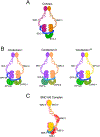How Chromatin Motor Complexes Influence the Nuclear Architecture: A Review of Chromatin Organization, Cohesins, and Condensins with a Focus on C. elegans
- PMID: 39726802
- PMCID: PMC11671135
- DOI: 10.3390/dna4010005
How Chromatin Motor Complexes Influence the Nuclear Architecture: A Review of Chromatin Organization, Cohesins, and Condensins with a Focus on C. elegans
Abstract
Chromatin is the complex of DNA and associated proteins found in the nuclei of living organisms. How it is organized is a major research field as it has implications for replication, repair, and gene expression. This review summarizes the current state of the chromatin organization field, with a special focus on chromatin motor complexes cohesin and condensin. Containing the highly conserved SMC proteins, these complexes are responsible for organizing chromatin during cell division. Additionally, research has demonstrated that condensin and cohesin also have important functions during interphase to shape the organization of chromatin and regulate expression of genes. Using the model organism C. elegans, the authors review the current knowledge of how these complexes perform such diverse roles and what open questions still exist in the field.
Keywords: C. elegans; SMC proteins; TADs; chromatin architecture; cohesin; condensin; dosage compensation.
Conflict of interest statement
Conflicts of Interest: The authors declare no competing financial interests.
Figures




Similar articles
-
Condensins and cohesins - one of these things is not like the other!J Cell Sci. 2019 Feb 7;132(3):jcs220491. doi: 10.1242/jcs.220491. J Cell Sci. 2019. PMID: 30733374 Free PMC article. Review.
-
Condensin I folds the Caenorhabditis elegans genome.Nat Genet. 2024 Aug;56(8):1737-1749. doi: 10.1038/s41588-024-01832-5. Epub 2024 Jul 22. Nat Genet. 2024. PMID: 39039278
-
Condensins and 3D Organization of the Interphase Nucleus.Curr Genet Med Rep. 2013 Dec 1;1(4):219-229. doi: 10.1007/s40142-013-0024-4. Curr Genet Med Rep. 2013. PMID: 24563825 Free PMC article.
-
Loop Extrusion Machinery Impairments in Models and Disease.Cells. 2024 Nov 17;13(22):1896. doi: 10.3390/cells13221896. Cells. 2024. PMID: 39594644 Free PMC article. Review.
-
The Arabidopsis condensin CAP-D subunits arrange interphase chromatin.New Phytol. 2021 May;230(3):972-987. doi: 10.1111/nph.17221. Epub 2021 Feb 25. New Phytol. 2021. PMID: 33475158
Cited by
-
Multi-level transcriptional regulation of embryonic sex determination and dosage compensation by the X-signal element sex-1.bioRxiv [Preprint]. 2024 Nov 24:2024.11.23.624987. doi: 10.1101/2024.11.23.624987. bioRxiv. 2024. PMID: 39605562 Free PMC article. Preprint.
References
-
- Lee JY; Orr-Weaver TL Chromatin. In Encyclopedia of Genetics; Brenner S, Miller JH, Eds.; Academic Press: New York, NY, USA, 2001; pp. 340–343.
Grants and funding
LinkOut - more resources
Full Text Sources
